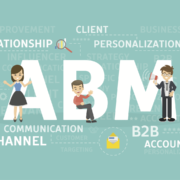Account-based Marketing

Account-Based Marketing (ABM) is a strategic approach that aligns marketing and sales teams to target specific high-value accounts and drive revenue growth. By orchestrating coordinated campaigns across multiple channels, ABM enables businesses to build stronger relationships, increase customer engagement, and improve sales efficiency. Stop using “Marketing-generated” with ABM. ABM is a team effort between marketing and sales.
Key Elements of ABM
- Account-Centric Focus: Shift your focus from individual leads to named accounts with significant revenue potential.
- Data-Driven Approach: Leverage clean and accurate account and contact data to fuel your ABM efforts.
- Integrated Marketing and Sales: Foster collaboration and alignment between marketing and sales teams to ensure a seamless customer experience.
- Personalized Outreach: Deliver highly targeted and personalized messages to each account.
- Continuous Optimization: Track key metrics, measure performance, and make data-driven adjustments to your ABM strategies.
Key ABM Performance Indicators (KPIs)
- Engaged Accounts: The number of accounts that have shown interest in your offerings.
- Account Contacts: The number of new contacts added to your target accounts’ database.
- Engaged to Opportunity: The conversion rate of engaged accounts into sales opportunities.
- Opportunity to Closed: The conversion rate of sales opportunities into closed deals.
Implementing ABM: A Phased Approach
- Assess Your Portfolio: Evaluate your target accounts based on their revenue potential and complexity.
- Prioritize Accounts: Focus on accounts with the highest potential for significant revenue.
- Develop Account-Based Plays: Create personalized marketing and sales strategies for each target account.
- Measure and Optimize: Track key metrics, analyze performance, and make adjustments as needed.
Challenges and Considerations
- Data Quality: Ensure your account and contact data is accurate and up-to-date.
- Organizational Alignment: Foster collaboration and alignment between marketing and sales teams.
- Cultural Change: Embrace a mindset shift towards account-based selling and customer-centricity.
Selected Technologies Enabling Account-Based Marketing (ABM)
- Customer Data Platforms (CDPs): CDPs unify customer data from various sources, providing a comprehensive view that fuels personalized marketing and targeted outreach.
- Segment: Segment offers a unified view of customer data across multiple channels.
- Tealium: Tealium provides a tag management platform for collecting and organizing customer data.
- Treasure Data: Treasure Data is a cloud-based customer data platform that enables real-time data analysis.
- Marketing Automation Platforms: These platforms automate repetitive tasks, nurture leads, and personalize communications based on individual preferences and behaviors.
- HubSpot: HubSpot offers a comprehensive marketing automation platform with features like email marketing, lead scoring, and reporting.
- Marketo: Marketo is a leading marketing automation platform with advanced features for ABM and personalized marketing.
- Pardot: Pardot is a salesforce.com company that offers marketing automation and sales enablement tools.
- Constant Contact Lead Gen and CRM: Formerly known as SharpSpring. the platform offers comprehensive marketing automation and CRM in an affordable integrated platform.
- Account-Based Marketing Platforms: Specialized ABM platforms offer features like account scoring, personalized journeys, and cross-channel orchestration.
- Demandbase: Demandbase specializes in ABM solutions, providing tools for account identification, targeting, and engagement.
- Terminus: Terminus offers a comprehensive ABM platform with features like account scoring, personalized journeys, and cross-channel orchestration.
- Engagio (Demandbase): Engagio is an ABM platform that helps businesses target and engage key accounts.
- 6sense: 6sense is an AI-powered ABM platform that provides insights into account engagement and intent data.
- Sales Enablement Platforms: Equip sales teams with the tools, content, and training needed to effectively engage with target accounts.
- Salesforce: Salesforce offers a CRM platform with sales enablement features like content management, coaching, and gamification.
- Highspot: Highspot provides a sales enablement platform for content management, training, and coaching.
- Showpad: Showpad is a sales enablement platform that helps teams access and share content, track performance, and enable coaching.
- CRM Systems: A robust CRM is essential for managing customer interactions, tracking opportunities, and measuring performance.
- Salesforce: Salesforce is a leading CRM platform with a wide range of features for sales, marketing, and customer service.
- Microsoft Dynamics 365: Microsoft’s CRM platform offers a suite of applications for sales, marketing, and customer service.
- HubSpot CRM: HubSpot’s CRM platform is integrated with its marketing automation tools for a seamless customer experience.
- Social Selling Tools: Platforms like LinkedIn Sales Navigator help identify decision-makers, engage in targeted outreach, and track interactions.
- LinkedIn Sales Navigator: LinkedIn’s premium sales tool provides insights into potential customers and helps build relationships.
- ZoomInfo: ZoomInfo offers a database of contact information and company data for sales professionals.
- Apollo.io: Apollo.io is a sales intelligence platform that helps identify and engage with potential customers.
- Data Enrichment Tools: Enhance your account data with additional information to create more personalized and relevant campaigns.
- ZoomInfo: ZoomInfo provides data enrichment capabilities to enhance your account and contact data.
- Dun & Bradstreet: Dun & Bradstreet offers a comprehensive database of business information.
- InsideView: InsideView provides data enrichment and sales intelligence solutions.
These technologies, when selected objectively and used together effectively, can empower your organization to execute successful ABM campaigns and drive revenue growth.
Benefits of ABM
- Increased Sales Efficiency: Focus your efforts on high-value accounts and improve conversion rates.
- Enhanced Customer Relationships: Build stronger relationships with key decision-makers.
- Improved ROI: Achieve a higher return on investment by targeting accounts with the greatest potential.
- Greater Market Penetration: Gain deeper insights into your target accounts and identify new opportunities.
By effectively implementing ABM, you can drive significant revenue growth and build stronger relationships with your most valuable customers.







Leave a Reply
Want to join the discussion?Feel free to contribute!